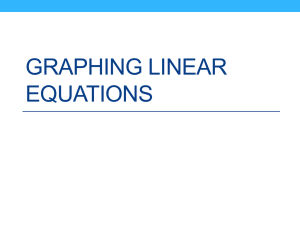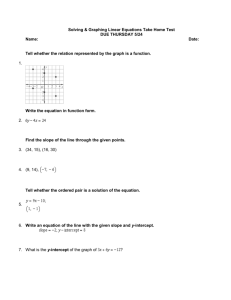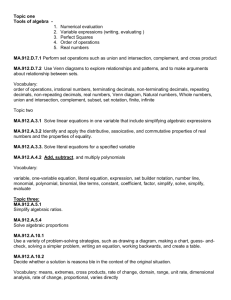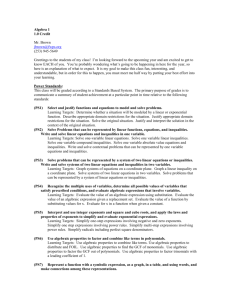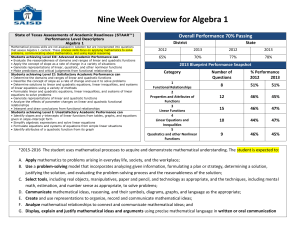Algebra 1 Proficiency Test Study Guide
advertisement
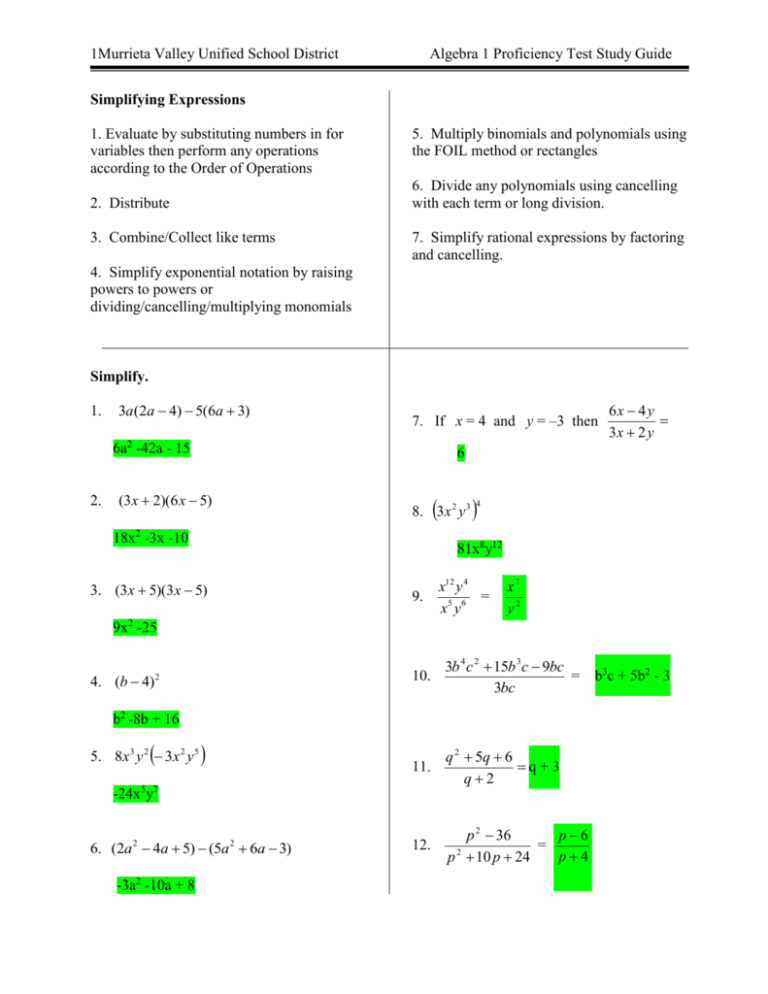
1Murrieta Valley Unified School District Algebra 1 Proficiency Test Study Guide Simplifying Expressions 1. Evaluate by substituting numbers in for variables then perform any operations according to the Order of Operations 5. Multiply binomials and polynomials using the FOIL method or rectangles 6. Divide any polynomials using cancelling with each term or long division. 2. Distribute 3. Combine/Collect like terms 7. Simplify rational expressions by factoring and cancelling. 4. Simplify exponential notation by raising powers to powers or dividing/cancelling/multiplying monomials Simplify. 1. 3a(2a 4) 5(6a 3) 7. If x = 4 and y = –3 then 6a2 -42a - 15 2. 6x 4 y 3x 2 y 6 (3x 2)(6 x 5) 8. 3x 2 y 3 18x2 -3x -10 4 81x8y12 3. (3 x 5)(3 x 5) 9. x12 y 4 = x5 y 6 x7 y2 9x2 -25 4. (b 4) 2 10. 3b 4 c 2 15b 3 c 9bc = b3c + 5b2 - 3 3bc 11. q 2 5q 6 q +3 q2 12. p6 p 2 36 = 2 p4 p 10 p 24 b2 -8b + 16 5. 8 x3 y 2 3x 2 y 5 -24x5y7 6. (2a 4a 5) (5a 6a 3) 2 -3a2 -10a + 8 2 Murrieta Valley Unified School District Solving Equations and Inequalities 1. Solve multi-step equations and inequalities in one variable by distributing, collecting like terms, isolating the variable, and solving by multiplying or dividing at the end. Don’t forget to flip the inequality symbol if you multiply or divide by a negative number! 2. Solve quadratic equations by factoring and using the zero product property or by using the quadratic formula. Remember that solutions to quadratic equations are the points where the graph would cross the x-axis! Solve: 13. 6 y 12 4 y 16 y = 14 Algebra 1 Proficiency Test Study Guide - 2 3. Solve rational equations by finding a common denominator then multiplying both sides of the equation by the common denominator then add or subtract to solve. Some rational equations can be solved as proportions. Always check for extraneous solutions! 4. Solve systems of equations using substitution or elimination. Be sure to express your solution as an ordered pair! 5. Be sure to consider the positive and negative cases when solving absolute value equations and inequalities. Remember to flip the inequality symbol with the negative case! 20. Solve the following system of equations: 2 x 4 y 8 ( 2, - 1 ) 3x y 5 x2 x4 6 4 14. 4( x 3) 5 x 3x 12 x=4 a 2 3 15. 5 3 10 5 a = -1 6 16. r 4 16 r = 20, -12 21. 17. 2x 6 4x 2 24. x 2 2 x 15 0 x > -4 a b 4 18. If , then b = -1 a b 6 19. Solve the following system of equations: y 4x 2 ( 2, 6 ) 4 x 2 y 20 x = 16 22. x2 + 7x – 18 = 0 x = -9, 2 23. Use the quadratic formula to solve the equation: x 2 7 x 4 0 7 33 x= 2 x = 5, -3 25. Where will the parabola cross the x-axis for the given equation? x 2 8 x 20 0 (-10, 0 ) and ( 2, 0 ) 26. There were 216 students at the dance. There were 8 more boys than girls. How many girls were at the dance? 104 girls Murrieta Valley Unified School District Algebra 1 Proficiency Test Study Guide - 2 Graphing Linear Equations and Inequalities 1. We can graph lines using t-charts, intercepts, or slope-intercept form y = mx + b. m represents the slope and b the y-intercept. Begin the graph at the y-intercept then count off the slope as rise over run. 5. To write an equation for a line when you know one point and the slope, use the point-slope formula. m is the slope and x1 and y1 are the coordinates of the given point. y – y1 = m ( x – x1 ) 2. Use the slope formula to find the slope of a line when you know two points: m = y2 y1 x2 x1 6. To graph linear inequalities, graph the boundary line. Use a solid line for > or <. Use a dashed line for > or < . Choose a checkpoint to determine which side of the boundary line to shade. 3. To find the x-intercept of the graph, let y = 0. To find the y-intercept, let x = 0. 4. Parallel lines have the same slope. Perpendicular lines have slopes that are opposite signed reciprocals of each other. 27. Solve for y: 3 x 4 y 12 3 y= x-3 4 28. Find the slope of the line that passes through the points (6, 10) and (-3, 2). 8 m= 9 29. Find the slope and y-intercept for the line: 5 x 3 y 15 5 Slope = y-int = 5 3 30. Find the x and y intercepts for the line: 3 x 6 y 18 x-int = (6, 0) y-int = (0, -3) 32. What is the slope of the line 3 4 perpendicular to y x 5 ? m = 4 3 2 33. Graph y x 3 3 y f(x)=2x/3 - 3 31. Write the equation of a line that has a slope of 3 and passes through the point (3, 5). y = 3x - 4 x 34. Graph the inequality 2 x 5 y 10 ? y f(x)=-2x/5 + 2 Shading 1 x Murrieta Valley Unified School District Algebra 1 Proficiency Test Study Guide - 2 Quadratic Polynomials 1. To factor a quadratic polynomial, first factor out the GCF if there is one. Then use the appropriate method: Difference of Squares (binomials) Diamonds (leading coefficient is 1) Diamonds and Rectangles (leading coefficient is not 1) 2. To complete the square, first “clear the space” by adding or subtracting “c” on both sides. Then divide “b” by 2 and square the answer. Add this number to both sides to complete the square. Factor the trinomial square then take the square root of both sides. Don’t forget the plus/minus! Finish solving the equation. Factor each of the following: 35. a2 – 36 (a+6)(a-6) 38. x 2 x 12 (x+4)(x–3) 36. 3x2 + 5x + 2 ( 3x + 2 ) ( x + 1 ) 39. What number completes the square: x2 + 22x + ____ 121 37. 3b3 + 15b2 + 18b 40. What number completes the square: 2x2 + 3x + ____ 3b ( b + 3 ) ( b + 2 ) 9 16 Murrieta Valley Unified School District Algebra 1 Proficiency Test Study Guide - 2

